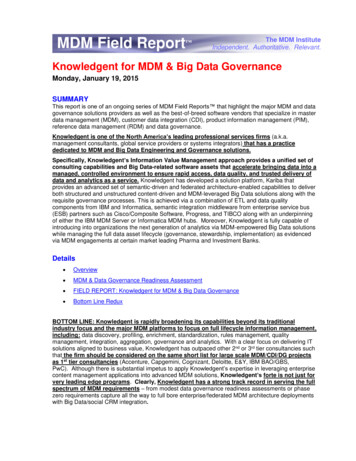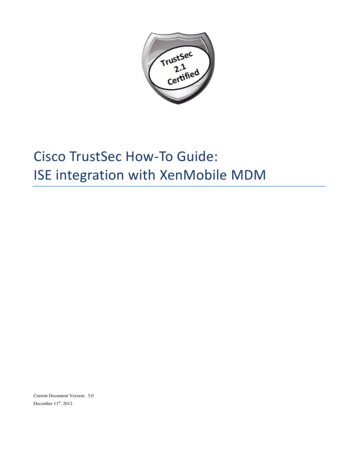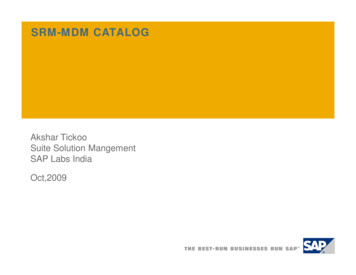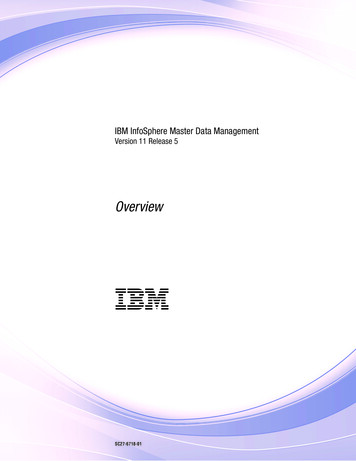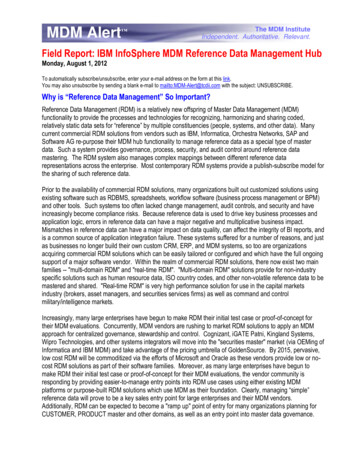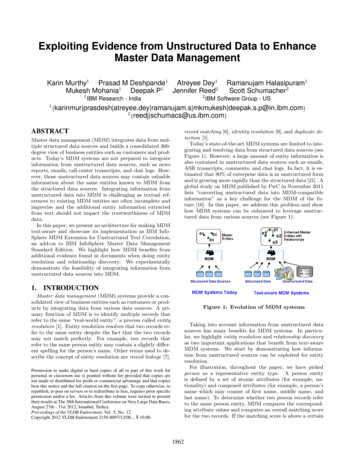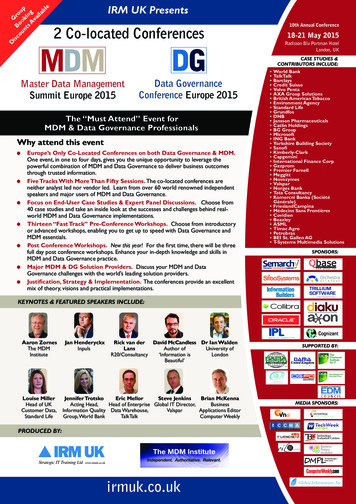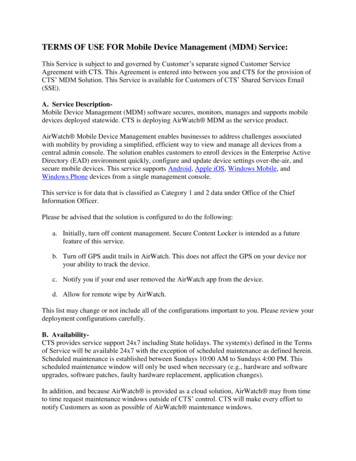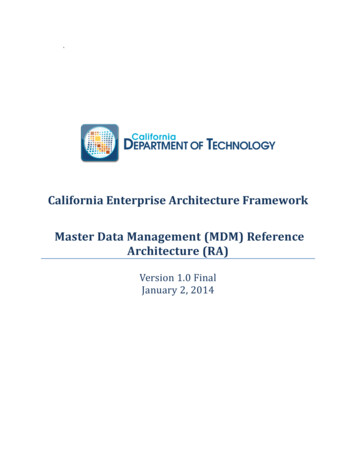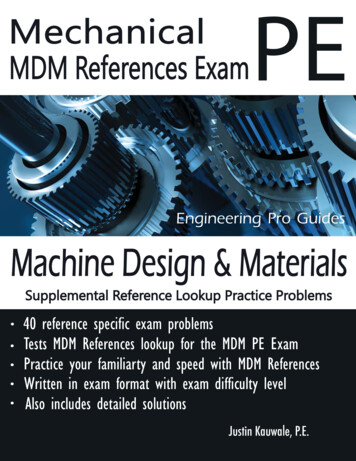
Transcription
MechanicalMDM References ExamPEEngineering Pro GuidesMachine Design & MaterialsSupplemental Reference Lookup Practice Problems40 reference specific exam problemsTests MDM References lookup for the MDM PE ExamPractice your familiarty and speed with MDM ReferencesWritten in exam format with exam difficulty levelAlso includes detailed solutionsJustin Kauwale, P.E.
SECTION 1INTRODUCTIONhttp://www.engproguides.com
IntroductionTable of Contents1.0 Introduction . 21.1 Key Concepts and Skills . 21.2 Units . 52.0 Disclaimer . 53.0 How to use this Book . 54.0Recommended References . 94.1A Mark’s Standard Handbook for Mechanical Engineers . 144.1B Machinery’s Handbook, Large Print . 144.2 Engineering Unit Conversions Book . 154.3 Engineering Mechanics – Statics & Dynamics . 154.4 Materials Science and Engineering: An Introduction 9th Edition . 154.5 Mechanics of Materials . 164.6 Machine Elements in Mechanical Design . 164.7 Useful Websites . 164.7.1Beam Design Formulas with Shear and Moment Diagrams. 174.7.2Welding Symbol Guide and Chart . 174.7.3Control Charts and Tables of Constants for Control Charts . 174.7.4Vibration Isolation . 174.7.5Websites for Machine Design Standards . 17Mechanical PE – Machine Design and MaterialsReferences Exam Introduction -1http://www.engproguides.com
1.0 INTRODUCTIONOne of the most important steps in an engineer's career is obtaining the professionalengineering (P.E.) license. It allows an individual to legally practice engineering in the state oflicensure. This credential can also help to obtain higher compensation and develop a crediblereputation. In order to obtain a P.E. license, the engineer must first meet the qualifications asrequired by the state of licensure, including minimum experience, references and the passing ofthe National Council of Examiners for Engineering and Surveying (NCEES) exam. EngineeringPro Guides focuses on helping engineers pass the NCEES exam through the use of freecontent on the website, http://www.engproguides.com and through the creation of books likesample exams and guides that outline and teach you how to pass the PE exam.The key to passing the PE exam is to learn the key concepts and skills that are tested on theexam. There are several issues that make this key very difficult. First, the key concepts andskills are unknown to most engineers studying for the exam. Second, the key concepts andskills are not contained in a single document. This technical guide teaches you the keyconcepts and skills required to pass the Machine Design & Materials Mechanical P.E. Exam.1.1 KEY CONCEPTS AND SKILLSHow are the key concepts and skills determined?The key concepts and skills taught and tested in the Technical Study Guide, References Examand Full Exam were first developed through an analysis of the topics and information presentedby NCEES. NCEES indicates on their website that the P.E. Exam will cover an AM exam (4hours) followed by a PM exam (4 hours) and that the exam will be 80 questions long, 40questions in the morning and 40 questions in the afternoon. The Machine Design & MaterialsMechanical PE exam will focus on the following topics as indicated by les (40 questions)A) Basic Engineering Practice (9 questions)1 Engineering terms and symbols2 Interpretation of technical drawings3 Quality assurance/quality control (QA/QC)4 Project management and economic analysis5 Units and conversions6 Design methodology (e.g., identifying requirements, risk assessment,verification/validation)B) Engineering Science and Mechanics (10 questions)1 Statics2 Kinematics3 DynamicsC) Material Properties (8 questions)1 Physical (e.g., density, melting point, optical)Mechanical PE – Machine Design and MaterialsReferences Exam Introduction -2http://www.engproguides.com
23Chemical (e.g., corrosion, alloys, oxidation)Mechanicali) Time-independent behavior (e.g., modulus, hardness, thermal expansion)ii) Time-dependent behavior (e.g., creep, viscoelastic, thermal conductivity)D) Strength of Materials (10 questions)1 Stress/strain (e.g., tension, compression)2 Shear3 Bending4 Buckling5 Torsion6 Fatigue7 Failure theories (e.g., Von Mises, maximum shear stress)E) Vibration (3 questions)1 Natural frequencies (e.g., linear, bending torsional) and acoustics2 Damping (e.g., frequency, damping ratio, critical damping)3 Forced vibrations (e.g., magnification factor, transmissibility, balancing, isolation)II.Applications (40 questions)A. Mechanical Components (18 questions)1. Pressure vessels and piping (e.g., thick/thin wall)2. Bearings (e.g., types, lubrication analysis, life-load analysis)3. Gears (e.g., types, speed analysis, force analysis)4. Springs (e.g., types, force analysis, fatigue analysis)5. Dampers (e.g., types, selection)6. Belt, pulley and chain drives (e.g., types, force analysis)7. Clutches and brakes (e.g., types, torque/force analysis)8. Power screws (e.g., types, lifting and lowering torque, locking conditions)9. Shafts and keys (e.g., torsion, bending, static/fatigue failure, stress risers)10. Mechanisms (e.g., linkages, cams, slider crank, levers, force analysis, kinetic analysis)11. Basic mechatronics (e.g., electromechanical interfaces, sensors, basic circuits, basiccontrols)12. Hydraulic and pneumatic components (e.g., pumps, cylinders, presses)13. Motors and engines (e.g., energy conservation, efficiency)B. Joints and Fasteners (12 questions)1. Welding and brazing (e.g., types, symbols, stress analysis)2. Bolts, screws, rivets (e.g., grade/class selection, preload, fastener group force analysis)3. Adhesives (e.g., types, analysis)C. Supportive Knowledge (10 questions)1. Manufacturing processes (e.g., machining, molding, heat treatment)2. Fits and tolerances3. Codes and standards4. Computational methods and their limitations (e.g., FEA, CAE)5. Testing and instrumentationMechanical PE – Machine Design and MaterialsReferences Exam Introduction -3http://www.engproguides.com
Next, each of these broad topics were investigated and filtered for concepts and skills that metthe following criteria:(1) First, the concept and skill must be commonly encountered in the Machine Design &Materials field of study. For example, in the Machine Design & Materials field: Calculatingstresses due to bending within a beam is a task that is regularly conducted, but the task ofcalculating the stress due to torsion in beams is not commonly encountered.(2) Second, the skill and concept must be testable in roughly 6 minutes per problem . Thereare (40) questions on the morning exam and you will be provided with 4 hours to complete theexam. The same is true for the afternoon portion of the exam. This results in an average of 6minutes per problem. This criterion limits the complexity of the exam problems and the resultingsolutions. For example, calculating the second moment of area in a 3-sided fillet weld iscommon in the Machine Design & Materials field, but the calculation is very lengthy because ofthe number of steps involved and is typically done on excel. Thus, you can eliminate thesetypes of lengthy calculations and you can expect that questions that involve lengthy calculationswill either give certain steps as given assumptions. The 6-minutes criterion and the low techcalculator also eliminates any complex mathematics.(3) Third, the key concepts and skills must be used or be known by practicing Mechanicalengineers in the Machine Design & Materials field. This criterion is similar to the first criterion.However, this criterion filters the concepts and skills further by limiting the field to materialencountered and used by practicing engineers . The Machine Design & Materials fields arevast and there are many different avenues an engineer can take. Two diverging paths arethose engineers involved in research and those who practice. Research engineers are pushingthe boundaries of the field and are highly focused in their specific area of the field. TheProfessional Engineering exam does not cover emerging technologies or highly focusedmaterial. The exam focuses on material that practicing engineers may use in their day to daycareers.(4) The P.E. Exam must test the principle or application of the skill and concept and not thebackground knowledge of the topic or concept. The exam also does not cover backgroundinformation on the NCEES topics. The P.E. Exam is meant to prove that the test taker isminimally competent to practice in the Mechanical Engineering – Machine Design field. Theexam is less concerned with theory and more with the principle or application of the theory, skillor concept. For example, the P.E. exam is less concerned with the derivation of the beamdeflection formulas and more concerned with your ability to use those formulas to determinedeflection and stress.In summary, the Technical Study Guide, Full Exam and References Exam are intended to teachand test the necessary skills and concepts required to be a minimally competent, practicingprofessional engineer in the Mechanical Engineering – Machine Design & Materials field.Mechanical PE – Machine Design and MaterialsReferences Exam Introduction -4http://www.engproguides.com
1.2 UNITSThe primary units that are used in the P.E. Exam are United States Customary System Units(USCS). As such, this guide focuses exclusively on the USCS. However, it is recommendedthat the test taker have a conversion book, because certain areas of the P.E. Exam may use theInternational System of Units (SI).2.0 DISCLAIMERIn no event will Engineering Pro Guides be liable for any incidental, indirect, consequential,punitive or special damages of any kind, or any other damages whatsoever, including, withoutlimitation, those resulting from loss of profit, loss of contracts, loss of reputation, goodwill, data,information, income, anticipated savings or business relationships, whether or not EngineeringPro Guides has been advised of the possibility of such damage, arising out of or in connectionwith the use of this document or any referenced documents and/or websites.This book was created on the basis of determining an independent interpretation of theminimum required knowledge and skills of a professional engineer. In no way does thisdocument represent the National Council of Examiners for Engineers and Surveying views orthe views of any other professional engineering society.3.0 HOW TO USE THIS BOOKFirst, it is recommended that the engineer in training gather the recommended referencespresented in the following section.Engineering Pro Guides sample exams can be used in multiple ways, depending on where youare in your study process. If you are at the beginning or middle, it can be used to test yourcompetency, gain an understanding and feel for the test format, and help to highlight targetareas to study. If you are at the end, it can be used to determine your preparedness for the realexam. Remember that the questions are a sample of the many topics that may be tested andare limited to fit a full exam length and therefore is not comprehensive of all concepts.Because the exam is written to be similar to the difficulty and format of the NCEES exam, it isrecommended that the test be completed in one sitting and timed for (2) four hour sessions tosimulate the real exam. This will give you a better indication of your status of preparation for theexam.Review the exam day rules and replicate the environment for the real test as much as possible,including the type of calculator you may use and the acceptable references. Keep a watch orclock next to you to gauge your pace for 40 questions in 4 hours.Mechanical PE – Machine Design and MaterialsReferences Exam Introduction -5http://www.engproguides.com
Based on the NCEES website, the following are general rules for exam day.Allowed:1. Snacks that are not disruptive to others2. Watches and small clocks3. Religious head coverings4. Two straight edges: e.g. ruler, scale, protractor, triangle5. Approved references6. Approved calculator (2 recommended for backup)7. Eyeglasses8. Non electronic magnifying glass9. (Units conversion book is also recommended)Prohibited:1. Cell phones2. Hats and hoods3. Slide charts, wheel charts, drafting compasses4. Weapons5. Tobacco6. Personal Chairs7. Eyeglass/Magnifying glass cases8. Scratch Paper (all writing must be done in the exam booklet)For additional references on exam day policies, exam day processes, and items to bringon your exam day, review the NCEES Examinee r to the NCEES exam, the tested topics are presented in a random order. For best use ofyour time, answer the questions that you know first and return to the questions that you areunfamiliar with later. Once all the known questions are answered, go through the test again andattempt to answer the remaining questions by level of difficulty. If time allots, review youranswers.If you are stuck on a question, seek the following avenues.1. Study Guide: It is important to understand your study guides and indices. During timesof uncertainty, these will likely lead you to your answers. Determine the key concept thatis being asked in the question and refer to your indices or pre-tabbed sections. Theconcepts will likely be found in one of the references, listed below.2. Process of Elimination: There are only four possible choices for each question. Askyourself if there is an answer that does not make sense and eliminate it. Further narrowdown the answer that are derived from equations or concepts that you know are not rightand are instead meant to deceive the test taker. See if there are answers that aresimilar or separated by something like a conversion error. This may be an indication thatthe correct equation was used.Mechanical PE – Machine Design and MaterialsReferences Exam Introduction -6http://www.engproguides.com
3. Educated Guess: Remember that there is no penalty for wrong answers. Hopefully withthe process of elimination you are able to narrow down as many answers as possibleand are able to create an educated guess.4. Rules of Thumb: Rules of thumb can be used to not only speed up time, but to help leadyou in the right direction.5. If the time is almost up and there are still unanswered questions remaining, determinewhether it makes sense to check for mistakes on the problems you do know how tosolve, or to tackle the unanswered problems.Typical Exam Verbiage/Design:1. Most Nearly: Due to rounding differences, the exam answers will not match yoursexactly and in fact may not closely resemble your answer. NCEES uses the term “mostnearly” to test your confidence in your solution. When the question prompts you with“most nearly”, choose the answer that most closely matches yours, whether it be greaterthan or lesser to your value.2. Irrelevant Information: The exam is intended to test your overall understanding ofconcepts. At times the question will include unnecessary information that is meant tomisdirect you.3. Deceiving Answers: NCEES wants to know that you are able to determine theappropriate methods for the solutions. There are answers that were intentionallyproduced from wrong equations to mislead the test taker. For example, you may forgeta 1/2 in the formula, KE (1/2)MV2 and there would be two answers each off by a factorof 1/2.4. Do Not Overanalyze: The exam questions are meant to be completed in 6 minutes.Therefore, they are intended to be written as straight forward as possible. Do not betempted to overanalyze the meaning of a question. This will only lead you down thewrong path.Review the Solutions:Once the sample test is completed, grade your results. Measure your aptitude in speed,concept comprehension, and overall score. If you score is above 75% then you are in goodshape. This 75% score is only applicable if you have prepared completely for the exam. If youare just starting out, then please do not be worried about a low score. This number is also just arule of thumb; there is no definite score to determine passing the test. Instead, NCEEScalibrates the results against practicing professional engineers. See thispage http://ncees.org/exams/scoring-process/ for a better understanding of how NCEES gradesthe scores.Mechanical PE – Machine Design and MaterialsReferences Exam Introduction -7http://www.engproguides.com
Review the answers that you got wrong and use the solutions as a learning tool on how toaddress these types of problems. Compare the types of questions you are missing with theNCEES outline of topics and determine where you should focus your studying. Finally repeat asmany practice problems as you can to get a better grasp of the test and to continually improveyour score.Mechanical PE – Machine Design and MaterialsReferences Exam Introduction -8http://www.engproguides.com
4.0 RECOMMENDED REFERENCESThe following references are recommended to be reviewed prior to the exam and/or used duringthe exam. When reviewing these references, make sure you first understand the content.Some of these references do not go into depth on explaining the equations or concepts but aresimply references. Others provide more background information and explanation on theNCEES topics. You should also be very familiar with the indices of these references and shouldbe able to navigate the references to find information quickly. This may require you to inserttabs into the references. Once you have completed these two tasks then you should be readyto use these references during the exam. (Tip: It is helpful to have the indices of yourreferences printed separately to allow you to have both the index and the reference materialopen at the same time, making for quicker searches.)Complete List of References for the Machine Design & Materials PE ExambyEngineering Pro Guideswww.engproguides.comEngineering Pro Guides provides a power technical study guide that teaches the key concepts and skillsnecessary to pass the Machine Design & Materials PE Exam. If you have any suggestions to this list,please email me, Justin Kauwale, at contact@engproguides.com or provide a comment on the GoogleSpreadsheet or on the webpage.Topic 2.0Basic Engineering Practice9 of 80 problemsEngineering Terms and Symbols Machinery's Handbook, Large PrintMachinery's Handbook, Large PrintInterpretation of .org/itrends/2009/07/it200907/it070914.pdfkQuality Assurance/QualityControlProject Managementhttps://www.stat.auckland.ac.nz/ pdfhttp://www.math.upatras.gr/ tsantas/DownLoadFiles/hil61217 ch22.pdfMechanical PE – Machine Design and MaterialsReferences Exam Introduction -9http://www.engproguides.com
Economic AnalysisUnits and ConversionsEconomics FactorsCompound Interest TablesEngineering Unit ConversionsDesign Methodoloy (identifyingrequirements, risk assesssment, Machinery's Handbook, Large Printverification/validation)Topic 3.0Engineering Science andMechanics10 of 80 problemsEngineering Mechanics - Statics & DynamicsTopic fKinematicsEngineering Mechanics - Statics & DynamicsDynamicsEngineering Mechanics - Statics & DynamicsMaterial Properties8 of 80 problemsPhysical (density, melting point,optical)Mechanics of MaterialsChemical (corrosion, alloys,oxidation)Mechanics of MaterialsMechanical (modulus, hardness,Mechanics of Materialsthermal expansion)Topic 5.0Mechanical (creep, viscoelastic,thermal conductivity)Mechanics of MaterialsStrength of Materials10 of 80 problemsStress/strain (tension,compression)Mechanics of MaterialsShearMechanics of MaterialsBendingMechanics of MaterialsMechanical PE – Machine Design and MaterialsReferences Exam Introduction -10http://www.engproguides.com
Topic 6.0BucklingMechanics of MaterialsTorsionMechanics of MaterialsFatigueShigley's Mechanical Engineering DesignFailure Theories (Von mises,maximum shear)Shigley's Mechanical Engineering DesignVibration3 of 80 problemsNatural Frequencies (linear,Machinery's Handbook, Large Printbending, torsional) and acousticsDamping (frequency, dampingratio, critical rced Vibrations (magnificationfactor, ect.pdfbalancing, isolation)Topic 7.0Mechanical Components18 of 80 problemsPressure Vessels and Piping(thick/thin wall)Machinery's Handbook, Large PrintBearings (types, lubrication, lifeload analysis)Gears (types, speed, forceanalysis)Machinery's Handbook, Large PrintShigley's Mechanical Engineering DesignShigley's Mechanical Engineering DesignMachinery's Handbook, Large PrintSprings (types, force, fatigueanalysis)Shigley's Mechanical Engineering DesignDampers (types, selection)Machinery's Handbook, Large PrintBelt and Pulley (types, forceanalysis)Chain Drives (force analysis)Machinery's Handbook, Large PrintShigley's Mechanical Engineering DesignMachinery's Handbook, Large PrintMechanical PE – Machine Design and MaterialsReferences Exam Introduction -11http://www.engproguides.com
Clutches and Brakes (types,torque/force analysis)Machinery's Handbook, Large PrintPower Screws (lifting/loweringtorque, locking)Shigley's Mechanical Engineering DesignShafts (torsion, bending,static/fatigue failure,)Shigley's Mechanical Engineering DesignKeys (stress risers)Shigley's Mechanical Engineering DesignMechanisms (linkages, cams,slider crank)Machinery's Handbook, Large PrintMechanisms (force, kineticanalysis)Machinery's Handbook, Large PrintMechatronics (interfaces,sensors, circuits, ness units/bri/de/downloads/hyd formelsammlung en.pdfHydraulic Components (pump,cylinder, u/ dupenb/MET ers.pdfhttp://www.gearseds.com/files/Pneumatics Sample Lessons.pdfTopic 8.0Pneumatic Components(compressor, cylinder, /MeadCatalog/BimbaRefHandbook-Mead.pdfMotors & Engines (energy,efficiency)Machinery's Handbook, Large PrintJoints and Fasteners12 of 80 problemsWelding (types, symbols, stressanalysis)Shigley's Mechanical Engineering DesignBrazingMachinery's Handbook, Large PrintMechanical PE – Machine Design and MaterialsReferences Exam Introduction -12http://www.engproguides.com
Bolts, Screws, Rivets (grade/classMachinery's Handbook, Large Printselection)Bolts, Screws, Rivets (preload)Bolts, Screws, Rivets (fastenergroup analysis)Adhesives (types)Shigley's Mechanical Engineering DesignMachinery's Handbook, Large PrintShigley's Mechanical Engineering tp://www.engr.psu.edu/lcvideos/emech210/beam shear stress/beam shear/BeamShear.pdfAdhesives edu/faculty/dickc/Engineering/shearflowa.htmTopic 9.0Supportive Knowledge10 of 80 problemsManufacturing Processes(machining, molding)Machinery's Handbook, Large PrintManufacturing Processes (heattreatment)Machinery's Handbook, Large PrintFits and TolerancesMachinery's Handbook, Large PrintAmerican National Standards Institute (ANSI)Codes and StandardsAmerican Society for Testing and Materials (ASTM)American Welding Society (AWS)American Society of Mechanical Engineers (ASME)Mechanical PE – Machine Design and MaterialsReferences Exam Introduction -13http://www.engproguides.com
Underwriters Laboratories (UL)Society of Automotive Engineers (SAE)Computational Methods andtheir Limitations (FEA, CAE)Shigley's Mechanical Engineering ypesTesting and Instrumentation(hardness, strength, etc.)Machinery's Handbook, Large Printhttp://www.ametektest.com/productsPlease see the below link to the online version of this spreadsheet for any updates. You canalso read below about a majority of the different references. If you have any suggestions orquestions on the list, please email Justin at contact@engproguides.com or you can comment onthe online version of the spreadsheet.Link: 4.1A MARK’S STANDARD HANDBOOK FOR MECHANICAL ENGINEERSBy Michael Lindeburg PEThis book is referenced by the NCEES Machine Design sample exam problems. However, thenext book has similar information and much more information specific to Machine Design. If youdecide to purchase this book as one of your references, then as you go through the EngineeringPro Guides technical study guide or sample exam, you should tab the locations of thenecessary equations and various referenced tables.Amazon Link i: Mark's Standard Handbook for Mechanical Engineers, 12th EditionTopics Covered: Section 1.0 – Basic Engineering Practice, Section 7.0 MechanicalComponents, Section 8.0 Joints and Fasteners and Section 9.0 Supportive Knowledge4.1B MACHINERY’S HANDBOOK, LARGE PRINTBy Michael Lindeburg PEThis book is similar to the Mark’s Standard Handbook, but it has even more information. Youshould choose either Mark’s Standard Handbook or the Machinery’s Handbook, whichever oneyou feel more comfortable. As you go through the Engineering Pro Guides technical studyguide or sample exam, you should tab the locations in this book for the various referencedtables and component properties. This book is very large and a lot of the information is tooMechanical PE – Machine Design and MaterialsReferences Exam Introduction -14http://www.engproguides.com
detailed for the PE exam, but it is a good safety net for the random supportive knowledge typequestions that may occur on the PE exam.Amazon Link ii: Machinery's Handbook, Large PrintTopics Covered: Section 1.0 – Basic Engineering Practice, Section 7.0 MechanicalComponents, Section 8.0 Joints and Fasteners and Section 9.0 Supportive Knowledge4.2 ENGINEERING UNIT CONVERSIONS BOOKBy Michael Lindeburg PEThe Engineering Unit Conversions book is a recommended book to use during the exam andwhile studying for the exam. You should tab the most commonly used conversions that youencounter while studying and doing practice problems.Amazon Link: Engineering Unit ConversionsTopics Covered: Section 2.0 – Basic Engineering Practice – Units & Conversions4.3 ENGINEERING MECHANICS – STATICS & DYNAMICSBy R.C. HibbelerThis book is a great refresher to your college engineering class on statics & dynamics. If youhave your college textbooks, then those books should be sufficient for any additional informationyou need on this topics. However, if you don’t have your college textbook then you can look atgetting this book. This book covers statics, kinematics and dynamics. There are also momentof inertia tables and center of gravity tables that are also useful. This book is very expensiveand thus it is only recommended if you feel like you are weak in this topic, but if you did well incollege on this topic, then the material presented in the Engineering Pro Guides Technical StudyGuide should be sufficient.Amazon Link: Engineering Mechanics - Statics & DynamicsTopics Covered: Section 3.0 – Engineering Science and Mechanics (10 questions)4.4 MATERIALS SCIENCE AND ENGINEERING: AN INTRODUCTION 9TH EDITIONBy William D. Callister, Jr. and David G. RethwischSimilar to the previous reference, this book is only required if you do not have your collegeMaterials textbook and you are not comfortable with the skills and concepts presented in theEngineering Pro Guides Technical Study Guide. If you have your Materials textbook, but youare not comfortable with Section 4.0 Material Properties, then you should review your textbook.If you are not comfortable and you don’t own a Materials textbook, then you should review thisMechanical PE – Machine Design and MaterialsReferences Exam Introduction -15http://www.engproguides.com
recommended reference. This book covers the mechanical, physical and chemical propertiespresented on the NCEES Machine Design outline.Amazon Link: Materials Science and Engineerin
concepts and skills required to pass the Machine Design & Materials Mechanical P.E. Exam. 1.1 KEY CONCEPTS AND SKILLS How are the key concepts and skills determined? The key concepts and skills taught
